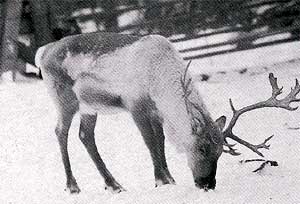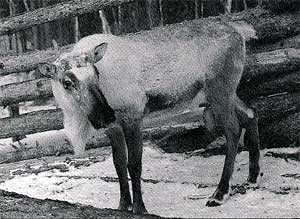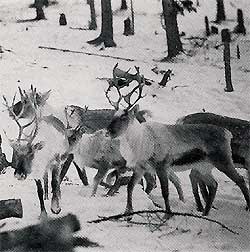Evenk Reindeer
 The Evenk breed was formed by the Evenk people, or their ancestors, and is distributed
everywhere this northern nationality lives. It is considered to be the oldest breed
and to have been the basis for developing other breeds. Archaeological findings give
evidence that deer raising for transport originated in southern Siberia, around Lake
Baikal, Tuva ASSR, Altai territory, where the ancestors of the present-day Evenks
dwelt. As a draft animal, which could also be used for riding and pack carrying, a
large and tall deer was needed, like the present-day Evenk breed. The ancient origin
of this breed is provided, among other things, by its differentiation into special
strains.
The Evenk breed was formed by the Evenk people, or their ancestors, and is distributed
everywhere this northern nationality lives. It is considered to be the oldest breed
and to have been the basis for developing other breeds. Archaeological findings give
evidence that deer raising for transport originated in southern Siberia, around Lake
Baikal, Tuva ASSR, Altai territory, where the ancestors of the present-day Evenks
dwelt. As a draft animal, which could also be used for riding and pack carrying, a
large and tall deer was needed, like the present-day Evenk breed. The ancient origin
of this breed is provided, among other things, by its differentiation into special
strains.
The total stock of the Evenk breed amounts to about 250,000 head. They are reared in the Taiga zone of Siberia and the Far East from the Yenisei to the coast of the sea of Okhotsk and Sakhalin Island. Most of them are in the Evenk Autonomous District, Yakutia, Buryatia and Tuva, Khabarovk territory, Irkutsk, Chita and Amur regions. Large size is distinguishing feature of reindeer in the Tava ASSR and Irkutsk region. According to a number of scholars, they form an independent strain - the Tuva-Tofalor type.
 The prevailing color is light brown but in eastern areas a considerable number of
gray animals can be seen.
The prevailing color is light brown but in eastern areas a considerable number of
gray animals can be seen.
The animals of this breed are known for their high load-carrying capacity and endurance and are still extensively used for transport.
As regards meat production they are second to no other breed of reindeer. The weight of fat adult stags is 70-85 kg, that of hinds 50-60 kg, the slaughter yield being 48-49%
The Evenk breed is well adapted to taiga conditions. In winter they easily scrape away snow to get their food and can dig holes over one meter deep. In summer and autumn the herd spreads far away from the fenced enclosures. During the rut they often stay in separate groups or herds.
 A state pedigree station, Surindinski, has been set up, where the best specimens of
the Evenk breed have been concentrated. This is actually, the only pedigree reindeer
plant in the world. The entire range of breeding work is being carried out here and
the genetic structure of the population is being investigated, as regards blood groups
and polymorphic serum proteins. On the basis of these data is possible, for the first
time, to establish the fawns paternity, which permits the introduction of line-breeding.
A state pedigree station, Surindinski, has been set up, where the best specimens of
the Evenk breed have been concentrated. This is actually, the only pedigree reindeer
plant in the world. The entire range of breeding work is being carried out here and
the genetic structure of the population is being investigated, as regards blood groups
and polymorphic serum proteins. On the basis of these data is possible, for the first
time, to establish the fawns paternity, which permits the introduction of line-breeding.
References
Dmitriez, N.G. and Ernst, L.K. (1989) Animal Genetic Resources of the USSR. Animal Production and Health Paper Publ. by FAO, Rome, 517 pp.
